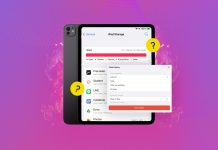If you’re familiar with rhythm games, and you haven’t experienced Mirror’s Edge on the iPad, you’re in for quite the treat. We’re on record as loving the game Canabalt, but Mirror’s Edge may just leap over the competition in the iPad sphere.
Faith, the main character in Mirror’s Edge, attempts to avoid police detection by running, jumping, and leaping across rooftops and obstacles as fast as possible. This is where a device like the iPad shines over something like an Xbox 360 controller. You swipe the screen to navigate your environment in a way that immerses you into the storyline far better than a console controller ever could.
The game mechanics are phenomenal. When Faith is running across the screen, swipe up and you jump, swipe down and you slide. If you’re charging towards an armed guard, you can either slide tackle him, or ninja kick him while flying through the air (swipe up, and then in the direction of the guard). Make no mistake though, this is a rhythm game at its finest. Mistime a take down or a jump and you’ll find yourself wishing you had planned your jump a little better.
But is it challenging?
The game provides a challenge in a way that a game like Run on the iPhone can’t even begin to create, sometimes in a good way, and sometimes in a way that is mind-blowingly annoying. There’s a couple sequences where you have to climb up an elevator shaft, or slide down a shaft without sliding through dangerous obstacles. tTese can become maddening pretty quickly. In a game that excels at having users make split second decisions, having to spend three or four minutes trying to figure out how to get up the shaft is a little bit of a let down. This game’s meant for speed, and any time something stands in the way of maximizing your velocity across the screen, you feel a little bit let down. These hurdlers are really small segments of the game play, and shouldn’t be a deterrent in your purchasing Mirror’s Edge for the iPad.
Mirror’s Edge is an experience worthy of the $12.99, and if there was ever a game that exhibits the potential of the iPad as a gaming platform, this may be it. So long as we keep in mind the confines in which the game is being played, Mirror’s Edge holds up to any of the other Mirror’s Edge games. Sure, the original may have been 3D, but taking the 3D mechanic, and turning the iPad version into a 2D platformer certainly works, and works well better than I would have imagined it would. Hardcore Mirror’s Edge fans might not enjoy the drastic change, but I personally embrace the differences between the Xbox360 version (get it on amazon, PS3, Xbox 360), and the iPad version, and it’s a whole new experience.
Innovation at its finest
If you’re looking for a game that demonstrates the new-age without taking old school control mechanisms and superimposing them over top of technologies like touch sensitive screens, then this game is for you. It’s innovation at its finest, and it really has me excited for the future of gaming. It’s hopefully going to spawn more innovation in a field where crappy touch screen controllers are the norm from the big development firms. Indie developers have been adopting this new game mechanic for years (ie. Firemint’s FlightControl, which is available for both the iPhone and the iPad), and Mirror’s Edge for the iPad is a clearl indicator that larger firms like EA are starting to really embrace the change.
You can buy Mirror’s Edge on the App Store.









